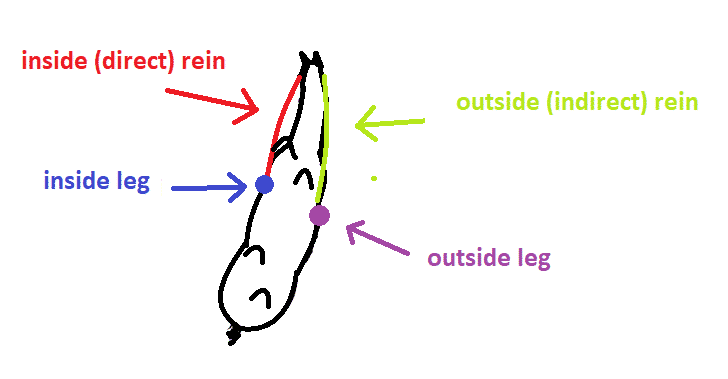
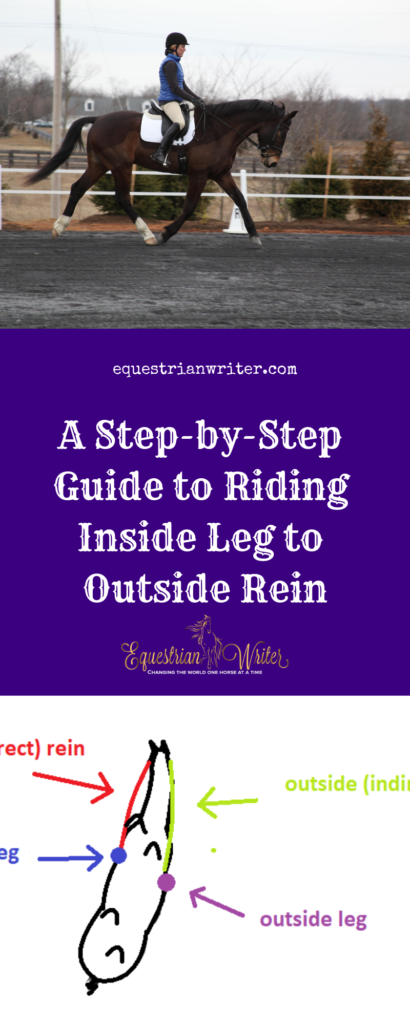
Riding inside leg to outside rein is one of the foundation exercises of classical dressage. Really, it should be the foundation for any discipline. It is a vital component that is a prerequisite for everything else you will learn in dressage. So, what is this inside leg to outside rein madness? How does it actually work?
The Mechanics of Inside Leg to Outside Rein
Understanding the mechanics of inside leg to outside rein is half the battle. Without a solid understanding of the mechanics, you can never even begin to truly master the art itself.
Inside Rein vs Outside Rein
Here is where a big difference lies. Inside leg to outside rein is in direct opposition the common notion of outside leg to inside rein. To clarify, outside leg to inside rein would be commonly know as direct reining. In commonly practiced direct reining, the horse is always taught to avoid all forms of pressure. In direct reining, the inside (direct) rein, guides the horse’s head in the direction of the turn and the outside leg reinforces this cue by pushing the horse in the direction of the turn.
In Figure A below, you see an illustrated example of a left turn. The left rein (inside direct rein) applies pressure while the right (outside indirect rein) stays slack. The right (outside) leg reinforces to cue by sliding forward just slightly to push the shoulder to the left while the left (inside) leg slides back just slightly to free up the shoulder and allow the horse to turn left. In theory this would seem logical. However, this fails to take into account the basic mechanics of equine movement.
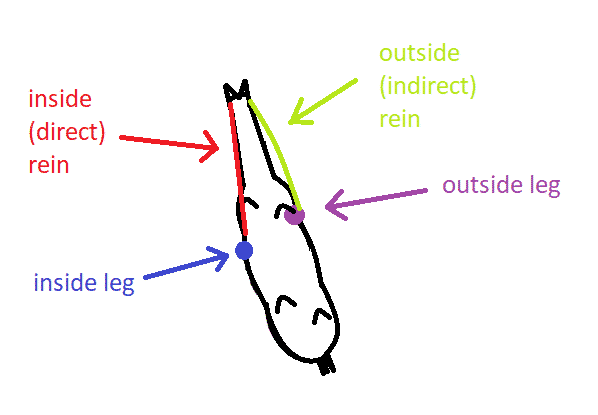
The Mechanics of Natural Equine Movement
Horses naturally lean to the inside and drop the inside shoulder when turning. This does not normally hinder them because they rarely need the same sharp, balanced turns out in the pasture that we ask of them in the arena. This natural tendency to lean and drop the shoulder is only magnified by the addition of the rider.
A rider changes the horse’s center gravity. Horses are already naturally heavy on the forehand. This is why rider posture is so important. We are asking them to shift their weight to their hindquarters while carrying between 100-200 lbs extra. That is not an easy task. Therefore, it is important for us to give them all the support we can.
Riding the Inside Shoulder
The inside shoulder is arguably the hardest part of the equation. It requires an in depth understanding of the mechanics and the coordination of so many little pieces.
Guiding the Shoulders
Do you know why everyone is always reminding you to look where you want the horse to go? If that always seemed strange to you, you’re not alone. No, horses don’t have some sort of magical ESP. The truth is it isn’t your eyes they are following, it’s your shoulders.
Try a little exercise for me. Sit or stand with your shoulders square like you should be when riding a horse. Now look to your left. Then, look to the right. Pay attention to what your shoulders do. Do they shift just slightly as you look?
It might only be the tiniest shift, barely even noticeable to you. However, your horse notices. He can be trained to ignore it, but that will only make him dull to your cues and you will notice that he stops responding as quickly to your aids.
Using the Shoulders to Shape the Turn
No matter what discipline you ride, the key to guiding you horse is always in his shoulders. Your eyes guide your shoulders and your shoulders guide your horse’s shoulders. All you have to do is point your shoulders where you want your horse’s shoulders to go.
Of course, this is easier said than done. It is important to keep your inside shoulder up. The moment you drop your shoulder, your horse drops his shoulder. Dropping the inside shoulder is exactly what we are trying to prevent.
Placement of the Hips
Here is the part that gets even more tricky. Your natural instinct might be to let your hips follow your shoulders. Don’t. In fact, your hips need to being doing the opposite of what your shoulders are doing. Your inside leg comes forward just slightly as your outside leg goes back. Your inside shoulder “picks up” your horse’s shoulder to the inside as your outside shoulder comes around to guide the horse through the turn (Figure B).
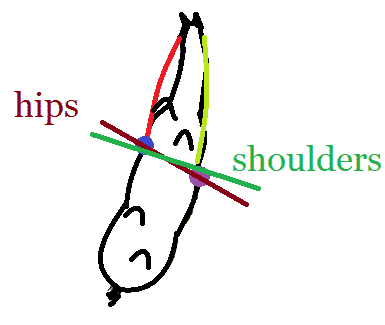
Here is another exercise for you to do. Stand up straight. Now, step off like you are going to turn left. What did your hips do? Your left hip came forward and your right hip came back. Most of the time when we are walking our arms move counter to the movement of our legs. So, if you were to move naturally, you will often find yourself bringing your left hip forward and your left shoulder back when stepping into a left turn. It is a natural movement for us when we are walking on two legs. Practice it. Become comfortable with the movement. Once you are comfortable on the ground to can begin attempting to transfer the movement into the saddle.
Riding the Outside Rein
The second–but no less vital–part of the equation is the outside rein. Picking up the inside shoulder is not enough. The horse also need support from the outside. The outside leg shifts back to maintain the bend through the turn, so it is up to the outside rein to support the horse through the turn.
It is all too easy for a horse to over-bend in a turn. This causes the outside shoulder to drift out and the inside shoulder to drop. The outside rein prevents this from happening by moderating the amount of bend. The outside rein should be making contact without pulling on the horse’s mouth. You should be able to the corner of the horse’s inside eye, but no more. The inside rein should make contact to help encourage bend, but the contact should be lighter than the outside rein. Ideally, you should be able to drop the inside rein completely and maintain a decent turn without it, although reaching that point will take some practice. Figure C demonstrates an approximation of the ideal way to ride inside leg to outside rein in a left turn.

How NOT to Ride
Now that you know how to ride inside rein to outside rein, let’s go back and look at the old outside rein to inside rein (direct reining) disaster in more detail.
As demonstrated in Figure D below, pulling on the inside rein uses bit pressure to steer the horse by force. Using the inside rein to create pressure in such a heavy handed manner leads to a far greater chance of bracing and resistance. This throws the horse off balance and over-bends him, causing his inside shoulder to drop and his outside shoulder to pop out. The outside leg applies pressure in a heavy-handed attempted to force the horse in the proper direction. As the horse is already off balance, this causes his inside shoulder to drop even further as there is no support from the inside leg which has moved back so as to–in theory–be out of the way. In reality, the inside leg is only succeeding in pushing the hindquarters out from under the horse. By now, we’ve discussed enough mechanics that I certainly hope you know what I’m going to say next. Yup. Pushing the hindquarters out from under the horse causes the inside shoulder to drop even more.
As you can see illustrated below, there are two lines down the center of the horse. The orange line demonstrates the counter bend created by direct reining. The gray line demonstrates the ideal bend that this horse would achieve if properly ridden inside leg to outside rein.
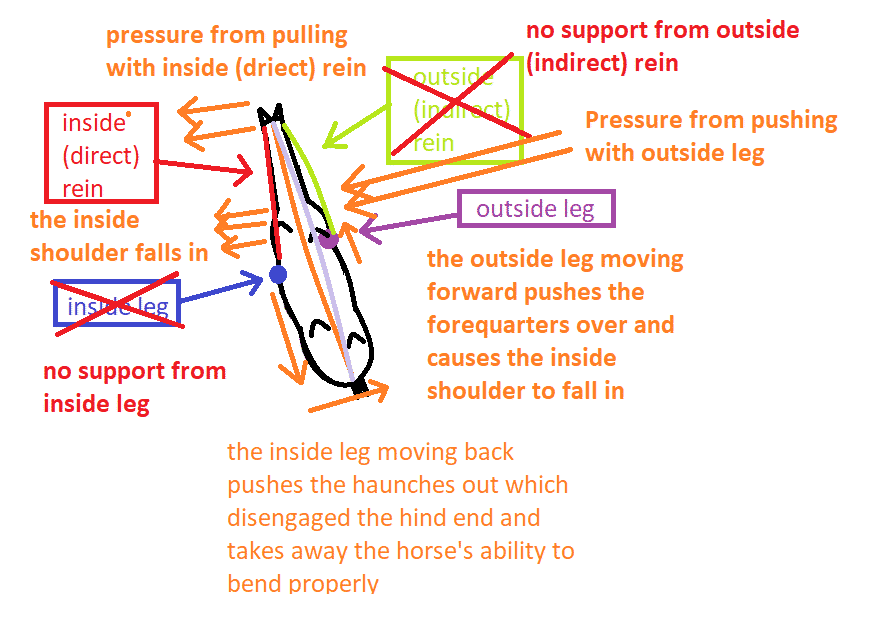
Further Applications for Inside Leg to Outside Rein
Riding inside leg to outside rein is the foundation for neck reining. Yes, you read that right. Western neck reining has its roots in classical dressage. This technique–while often attributed to classical dressage–is a vital tool for any discipline.






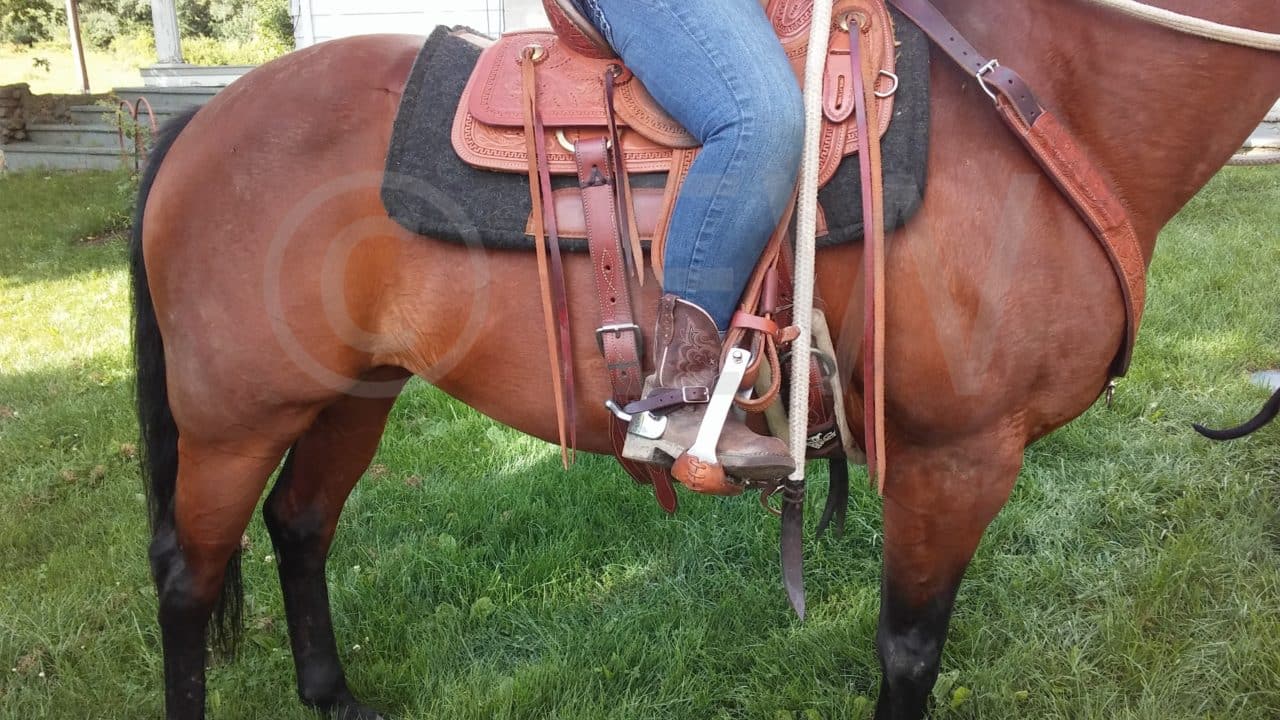
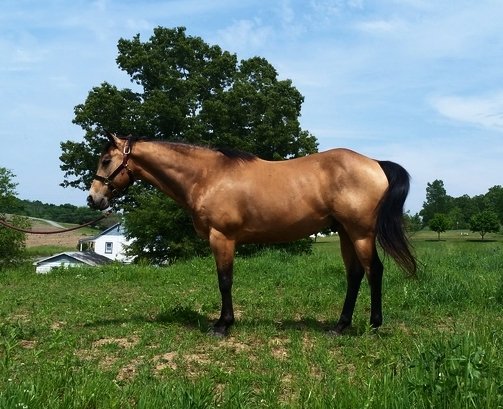

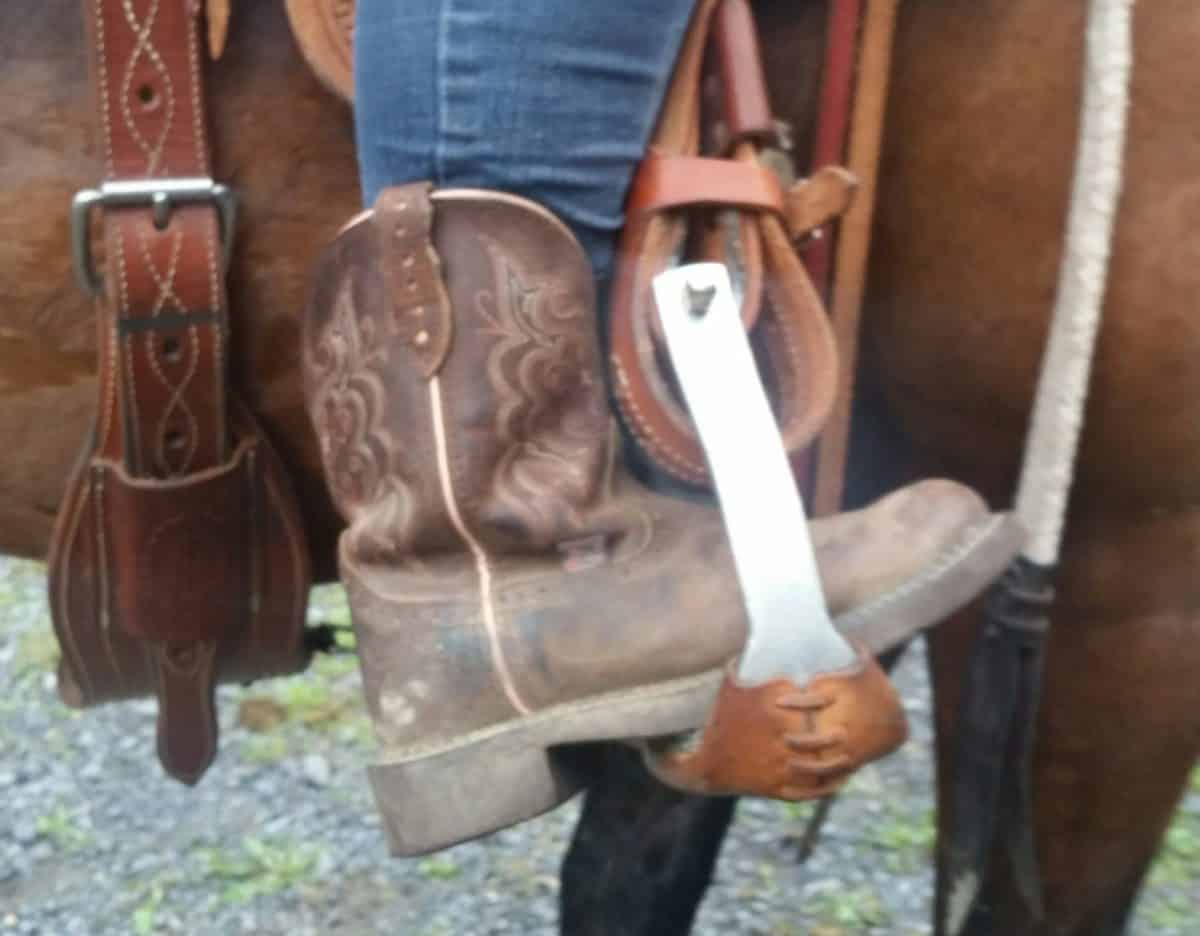
thank you so much. I ride at elementary level dressage and my horse is a short coupled treat. She is good at squirming out of something if I dont get the aids just right and this is really helpful. I tend to like visualising the hips and shoulders and so I practise too on foot.
The images are super.
Amanda
I would love a video. You explain really well but a video would clarify a few things.
Cheers,
Nanct
I need a video to accompany this.
Thank you for the feedback. I noticed there seem to be several readers who share the sentiment. I am just coming back from a long hiatus due to various health issues and my horse being off for a whole year due to injury. I hope to start working on videos for some of these older posts soon, although some might have to wait until poor Moose (my mare) gets back into riding shape. Right now she is quite out of shape and rather ornery due to the excessive time off. Oh the joys of dealing with mares. I will put this on the list of topics to be addressed with a demo video.
I’ve been riding for 20 years now and this is the best most helpful thing I’ve read. I’ve never felt I actually understood until now! Thank you! Great article.
I have not even began too read all that is here. But I am finding that it is exactly what I need as a new rider. I have rode my entire life. But now at 50 and owning a horse of my own, I want to understand what its all about and ride correctly. I want to do what is best for my horse. My 19 year old daughter wants the same. I just bought a TWH and want to learn how to make her comfortable and relaxed and happy. Thank you for taking the time and effort to connect and share your knowledge. You are amazing!
Actually “Jake”, I found this to be a wonderful complement to what I’ve been learning in training. It had me practicing in my chair, encouraged visualization, and thinking through my bodily movements. Bravo for a great post!
In addition to the diagrams and verbal instructions a video should be added, demonstrating both correct and incorrect methods. Reading and trying to follow this 5 or 6 colored diagram with the red cross out boxes is very confusing and unhelpful. But don’t take my word for it, recruit basic riders to read this and then gauge their actual comprhension of the material presented after they have completed the reading.